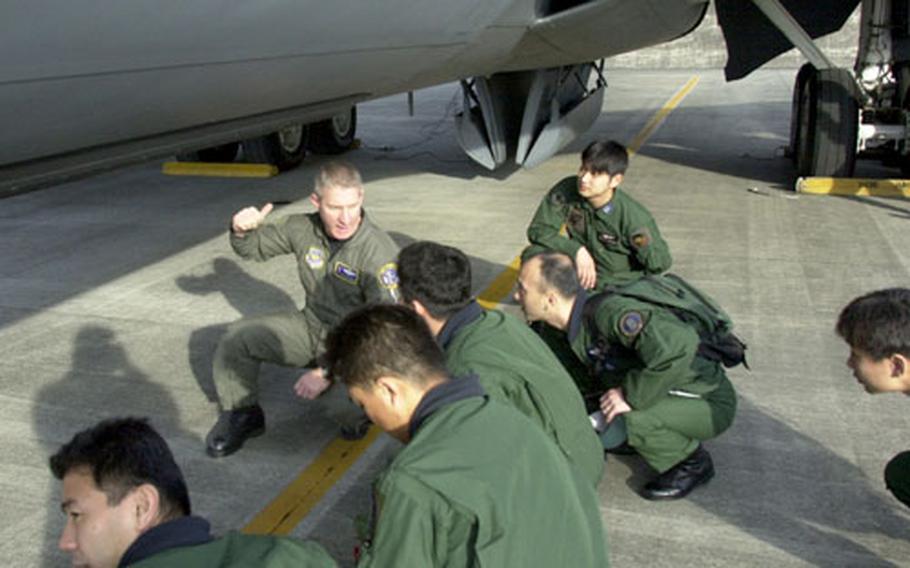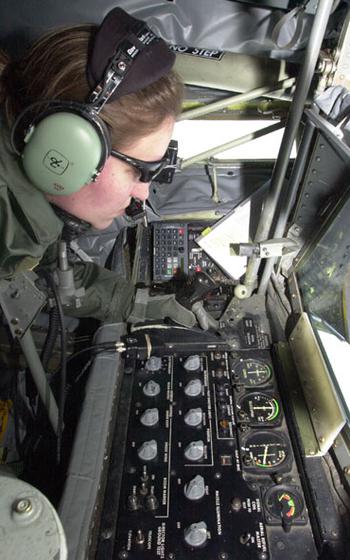
Chief Master Sgt. Sam Geros briefs Japanese Air Self Defense Force pilors before boarding the KC-135 refueling aircraft Tuesday. (Erik Slavin / S&S)
An F-15 lines up for refueling from a KC-135 aircraft off Okinawa’s coast Tuesday. (Erik Slavin / S&S)
KADENA AIR BASE, Okinawa — At 24,000 feet, Chief Master Sgt. Sam Geros lowers the boom.
He positions the telescoping boom pipe slightly to the right as an F-15 comes within 50 feet, cruising along at 360 mph.
The aircraft closes at about one foot per second until the boom enters the F-15’s gas tank opening, just above the cockpit.
In one minute, Geros delivers more fuel from his KC-135 to the hungry fighter plane than the average gas station pumps for the better part of a day.
Peering over Geros’ shoulder, Japanese fighter pilots admire the transfer while snapping away with their cameras and digital video cameras. It’s the first time they have witnessed an air-to-air refueling, thanks to a joint program set up between the Japanese Air Self-Defense Force and Kadena Air Base.
Twelve Japanese F-15 pilots from Chitose Air Base in Hokkaido and one program officer from Tokyo learned the finer points of air-to-air refueling from Kadena pilots and members of the Illinois National Guard on Tuesday and Wednesday.
“It’s new, and like anything it takes practice,” said Capt. Kevin “Kidd” Janasiewicz, a pilot with the 67th Fighter Squadron, who escorted the Japanese observers. “The training program is broken down so they get to see it from the back seat before moving up to the front.”

Tech Sgt. Michele Pfaff lines up a boom pipe to refuel an AWACS reconnaisance plane about 120 miles off Okinawa’s coast Tuesday. Pilots from the Japanese Air Self Defense Force observed from both planes as Kadena Air Base and Illinois National Guard airmen performed the transfer. (Erik Slavin)
The Chitose pilots from the 203rd Tactical Squadron also observed refueling onboard an F-15 and an AWACS reconnaissance plane about 120 miles off the Okinawan coast. Others observed from the refueler, manned by the 126th Air Refueling Wing, an Air National Guard unit from Scott Air Force Base in Illinois.
F-15s generally are easier and quicker to refuel than something like a larger AWACS plane, Geros said. But poor weather can make the connection between any two planes difficult.
“Turbulence and pilot experience are some of the biggest factors,” said Geros, which is why the AWACS pilot practiced flying in sync for several minutes before and after refueling.
The KC-135 holds up to 30,000 gallons of fuel, storing it along its base and even its wings. It’s not unusual to have four fighter planes flying on each wing, waiting for their turns, Geros said.
Geros and 135 airmen from Scott Air Force Base arrived at Kadena on March 3. Along with their refueling mission, they’ve flown medical evacuees from Misawa Air Base and Guam to Hawaii for advanced treatment.
Many of the wing’s maintenance airmen have spent 10 to 20 years working on their aircraft, said wing commander Col. Pete Nezamis.
“The experience gives us the opportunity to show some of the younger active-duty members different things technically than what they’re used to seeing,” he said.
Nezamis says foreign air force members often ask how a mostly part-time force can maintain readiness. Of the 900 members of Nezamis’ wing, about 70 percent are part-time reservists.
“A few regulations are different, but we maintain the exact standards of our active-duty counterparts,” Nezamis said.
Crewmembers spend 80 to 100 days at the unit per year on average, Nezamis said. Their reasons for service vary, but most want to serve while remaining closer to home, he said.
“They got out of active duty, but they’re just not ready to give up the uniform,” Nezamis said.